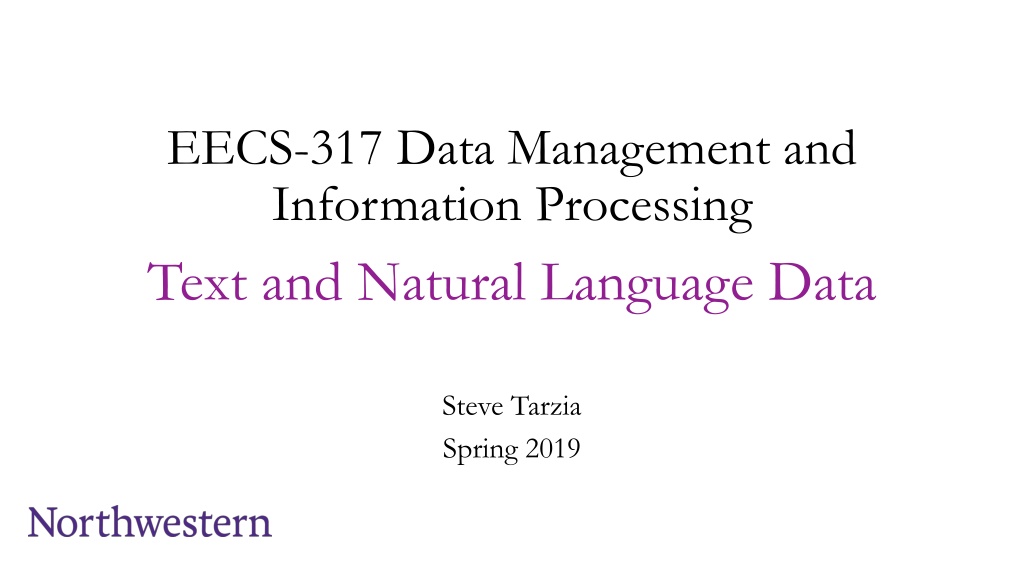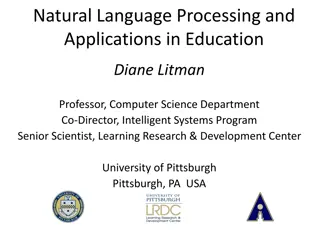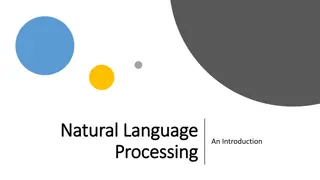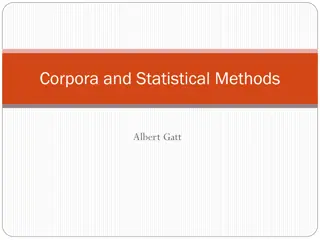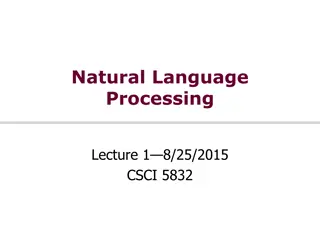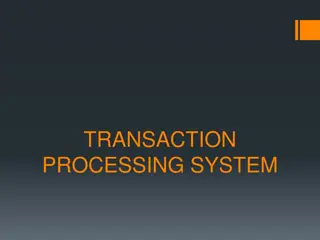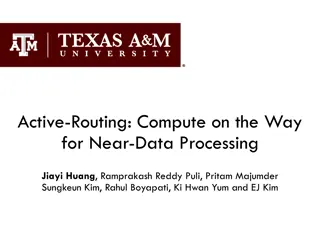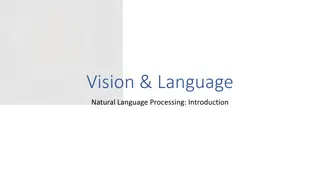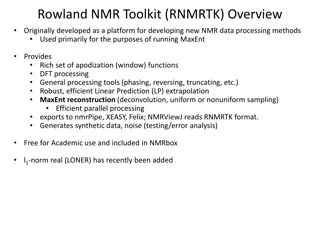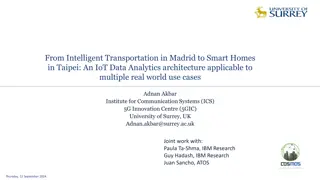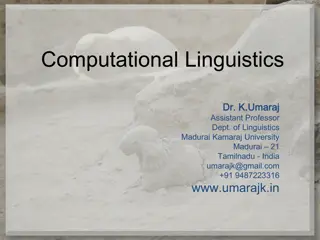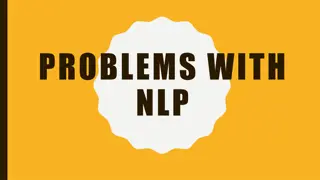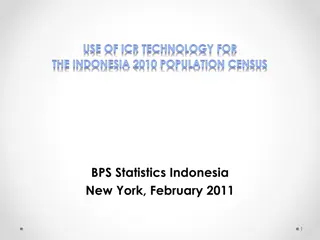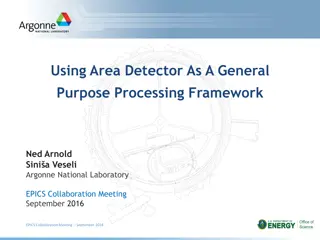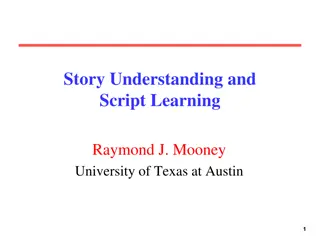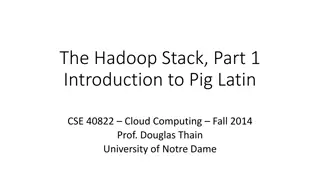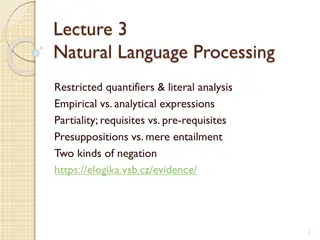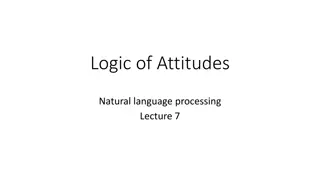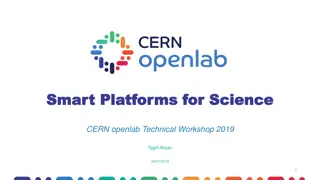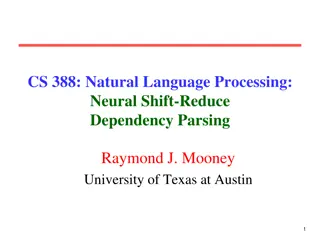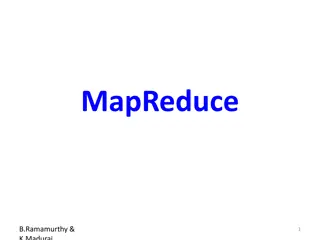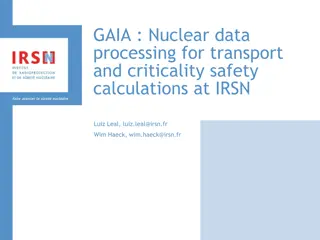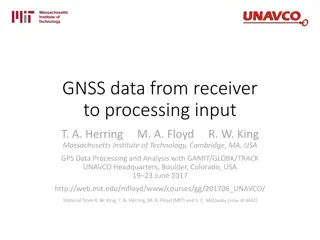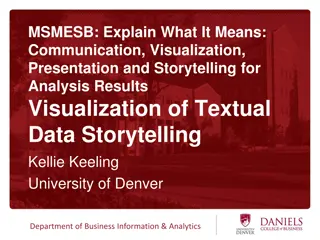Understanding Natural Language Data Processing
Exploring aspects of natural language data, covering topics like the differences between natural and formal languages, challenges in processing natural languages for machines, and examples of dealing with natural language data such as Yelp reviews. The content also touches on big data concepts, hash functions, distributed databases, and the use of SQL in pattern matching.
Download Presentation

Please find below an Image/Link to download the presentation.
The content on the website is provided AS IS for your information and personal use only. It may not be sold, licensed, or shared on other websites without obtaining consent from the author. Download presentation by click this link. If you encounter any issues during the download, it is possible that the publisher has removed the file from their server.
E N D
Presentation Transcript
EECS-317 Data Management and Information Processing Text and Natural Language Data Steve Tarzia Spring 2019
Announcements Final exam is in one week! Will cover SQL, database schema design, maybe a little on number representations. In other words, it will be similar to past final exams. Final project due in 13 days (June 12th)
Last Lecture: Big Data Hash functions map deterministically to pseudo-random values. A hash table is a data structure to store (key, value) pairs: Hashing the key determines the data s storage address. So, hashing is an alternative to binary search trees for indexing data. Big Data requires databases (or filesystems) distributed over many computers NoSQL databases are distributed hash tables. Lack the full power of SQL. Hadoop is a distributed computing platform, using MapReduce: Map function takes input and produces a bunch of intermediate results. Reduce function takes intermediate results and produces an output. Stop and think before using big data tools (SQL is pretty scalable!)
Natural Language Data Natural Language means a language that has evolved naturally. For example, written English or spoken English. These are human languages. In contrast, a Formal Language is defined by a strict set of rules. For example, SQL or Python. These are computer or mathematical languages. Natural languages are difficult for machines to process because there are no clear rules for semantics (meaning). Thus, natural language processing (NLP) is a difficult artificial intelligence problem. Eg., Siri, Alexa, Google search. Details of state-of-the-art NLP is way beyond the scope of this course
How to deal with natural language data? For example, Yelp reviews: Red, white and bleu salad was super yum and a great addition to the menu! This location was clean with great service and food served at just the right temps! Kids pizza is always a hit too with lots of great side dish options for the kiddos! When I'm on this side of town, this will definitely be a spot I'll hit up again! Ate the momos during the momo crawl.. Was the best of the lot so decided to eat at the restaurant and the mutton thali was equally good!! Pizza here made my night... Good people and great pizza. They can do anything you ask with a great attitude! Great brisket sandwich as claimed. Weird that it's a gas station/ hipster bbq lunch spot/ hallmark store carwash. Interesting food, great atmosphere, and great service. I like this place because there really isn't anything like this around the Charlotte area. I will definitely be coming back! Oh, and MILK BREAD.
Pattern matching In SQL, you can use LIKE or REGEXP to find patterns Eg., it might be useful to find all the reviews mentioning Pizza: SELECT text FROM review WHERE text LIKE "%pizza% ; Red, white and bleu salad was super yum and a great addition to the menu! This location was clean with great service and food served at just the right temps! Kids pizza is always a hit too with lots of great side dish options for the kiddos! When I'm on this side of town, this will definitely be a spot I'll hit up again! Pizza here made my night... Good people and great pizza. They can do anything you ask with a great attitude! Another case of the Emperor's New Clothes. Someone of the artsy set decided that this relatively good but overpriced fare was great pizza and all the lemmings followed suit. Will anyone tell the Emperor he has no clothes? The limited hours, no delivery, and lack of dining area add to the snob appeal. Don't be taken in.
Regular Expressions (REGEXP) Regular Expressions are patterns that match text. WHERE column REGEXP "pattern They are much more flexible than the LIKE expressions we have used. LIKE expressions use % to represent a sequence of unknown characters and _ to represent a single unknown character. Regular Expressions can be much more specific: Match different types of characters (letters, numbers, whitespace) Allows sub-patterns to repeat and more SQLite, MySQL, and every major DBMS support REGEXP, although the syntax details may vary. Regular Expressions are also used in many other programing languages and for searching with files using: grep command-line tool on Mac and Unix. FINDSTR and Select-String commands on Windows. pattern"
A simple Regular Expression Returns true only if the pattern is present in the text. Is case sensitive. barf matches: barf barfly I embarfed on my journey. I barfed at McDonalds. barf does not match: Barf BARF This bar finally closed. I enjoyed my meal at McDonalds. arf
To experiment with Regular Expressions In SQLite: SELECT "Some String" REGEXP "tri"; Will return 1 (true) if it matches. In Mac Terminal.app: echo "Some String" | grep "tri" --color=always Will print the string if it matches. In the Windows command prompt: echo "Some String" | findstr "tri"
Beginning and end of the text Normally, regular expressions match anywhere in the text, but we can change that behavior as follows: ^ represents the beginning of the text $ represents the end of the text ^Hellomatches Hello World. but does not match Big Hello world$ matches hello world but does not match world cup ^hello world$ matches hello world and nothing else.
Sets of characters . (period) matches any one character (as does _ with LIKE expressions) m.p matches map mop mope but not dimple nor mousetrap Square braces [ ] specify a set of characters, any of which can match. [aA] specifies either a or A [a-z] specifies any of the characters between a and z [^b] specifies any character other than b These sets can be combined, as follows: [a-zA-Z013] specifies any English letter or numbers 0, 1, or 3 [^CDA] specifies any character other than C D or A
Examples ^[Dd]atabasematches: Database , databases , Database Mgmt does not match: My Database , data C[aeiou][b-d] matches: Cab , Abra Cadabra , Cob , Cic does not match: Clad , CB matches: Cab , ccc , Green catnip , MacBride does not match: Clad , cab , CB [Cc].[^aeiou]
Repetition * lets the previous thing repeat any number of times, including zero times. .*matches anything because it s any one character repeated any number of times. + lets the previous thing repeat one or more times. ? makes the previous thing optional (appears zero or one times). {n,m} lets the previous thing repeat between n and m times. The pipe character gives OR: (this|that)
Examples ^1.*t$ matches: 12 point , 100.3 feet , 111ttt , 1t does not match: This 12 point font [Cc]ats? matches: Cat behavior , 5 cats , catnip does not match: cast , CATS matches: 249032/b , 23. , does not match: a , aa , 1 [0-9]+.[a-z]? ([cC]at|[Dd]og)( food)? matches: cat food , Dog does not match: food
Car license plate example Let s say we want to match text that could be car license plates. Must be 6 to 8 characters, optionally with a space or dash in the middle. Eg., 123-AB3 or 4FDK930 [A-Z0-9]{3,4}[ \-]?[A-Z0-9]{3,4} 3 or 4 capital letters or numbers 3 or 4 capital letters or numbers Optional space or hyphen \ is needed to escape the normal meaning of hyphen inside square brackets. We want the literal hyphen character; we are not specifying a range of characters.
Special characters Whitespace in text is represented by a variety of characters: \t is the tab character \n is newline \r is carriage return Unix-style text ends each line with \n Windows-style text ends each line with \r\n To match any whitespace, use [ \t\n\r] or simply \s \w represents a word character , meaning anything other than whitespace: [^\s]
Regex Summary Regular expressions are used to match text, both in SQL and in many other data management tools. A match anywhere in the text returns true. ^ anchors to the beginning $ anchors to the end . matches any character [ ] specifies a set of possible characters [a-z] hyphen specifies a range [^abc] carrot within brackets negates the match Repetitions are supported: * any number + one or more ? zero or one {n,m} n to m repetitions | pipe character gives OR ( ) can be used for grouping
But patterns alone cannot capture deep meaning Let s say I want to find all the positive reviews. Is this a positive review? Interesting food, great atmosphere, and great service. I like this place because there really isn't anything like this around the Charlotte area. I will definitely be coming back! Oh, and MILK BREAD. How can we use pattern matching to find positive reviews? Maybe search for reviews with positive words? good, great, love, excellent, best, happy, What if review has both positive and negative words? Our waiter did a great job of ignoringour table. Should all words have equal weight?
Word frequency vectors If we treat the text as just a bag of words we lose some meaning (the ordering of words is lost), but easy comparisons become possible. A word frequency vector has a dimension for each possible word and the value in that dimension represents the frequency of that word. Might have 30,000 dimensions: [a, Aachen, aah, aardvark, , zygote, zymurgy, zzz] Any text can be represented by such a vector: I like cats like that. [0, , 0, 0.2, 0, 0, 0.2, 0, , 0, 0.4, 0, , 0, 0.2, 0, 0] 8,301st dimension is cats Represent each text as a point in a space of extremely high dimension. 12,401st is I 13,021st is like. 21,022nd is that
Shakespeare plays Word frequency vectors can be calculated for very large documents. For example, Shakespeare plays: As You Like It battle 1 Twelfth Night 0 Julius Caesar 7 Henry V 13 good 114 80 62 89 fool 36 58 1 4 wit 20 15 2 3 Above, we are showing just four of the many dimensions of the WFV. Some words are more important than others for a particular task.
Looking at just two dimensions of the WFV: Dramas 40 Henry V [4,13] 15 battle 10 Julius Caesar [1,7] Comedies 5 Twelfth Night [58,0] As You Like It [36,1] 5 10 15 20 25 30 fool 35 40 45 50 55 60 The frequency of words battle and fool are very different for comedies and the dramas (histories and tragedies). These two dimensions of the WFV can help in classifying these documents.
Similarity of WFVs Word frequency vectors are often compared by the angle between them, which is called the cosine similarity: 40 Henry V [4,13] 15 battle 10 Julius Caesar [1,7] 5 Twelfth Night [58,0] As You Like It [36,1] Cosine similarity will be 1 if WFCs are identical, 0 if they are completely orthogonal. Above, there is a large angle between Julius Caesar and As You Like It (their WFVs are not very similar). However, As You Like It and Twelfth Night are much closer (more similar) 5 10 15 20 25 30 fool 35 40 45 50 55 60
Back to finding positive reviews Each review is a point in word- frequency space: Using word-frequency vectors, we can represent each review as a point/vector in an extremely high- dimensional space. Similar to the picture at right, but with > 10,000 dimensions instead of just 3D. We assume that the positive reviews occupy some region of the space. If we have a few reviews that we know are positive (training data) then we can look for review that are close to those in the space. That s the essence of supervised machine learning.
Reducing dimension of the vectors If each dimension represents a word, then 10,000+ dimensions are needed. However, many words are similar, especially if we re ignoring ordering. Principle component analysis (PCA) and similar techniques can be used to reduce dimensionality. Word embeddings define each possible word as a vector in a much smaller dimension space (perhaps 200). This is done by analyzing a huge language corpus, like all of Wikipedia. Now, you can translate a bag of words into a vector in this 200-dimensional space by multiplying the frequency of each word by it s word embedding vector and summing them all up.
Recap: Text and Natural language Data Text is somewhat difficult to analyze. Patterns can be found using Regular Expressions. However, more intelligent analyses require AI techniques. Word Frequency Vectors treat the text as a bag of words and assume that different meaning usually involves different sets of words. Cosine similarity can measure differences in WFVs. Gave examples of: Document classification, review sentiment (positive/negative) Also applies to email spam detection, etc.
